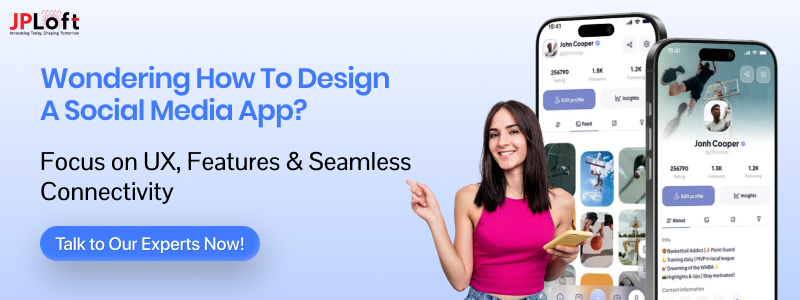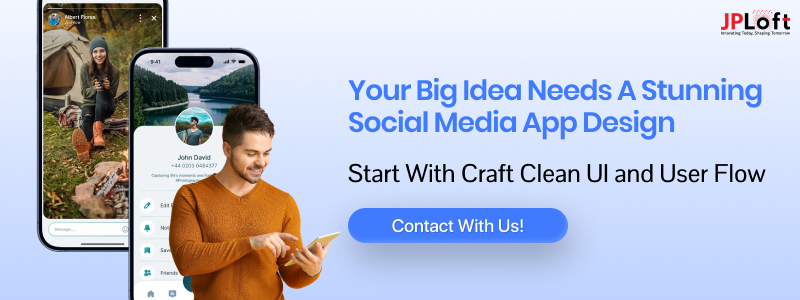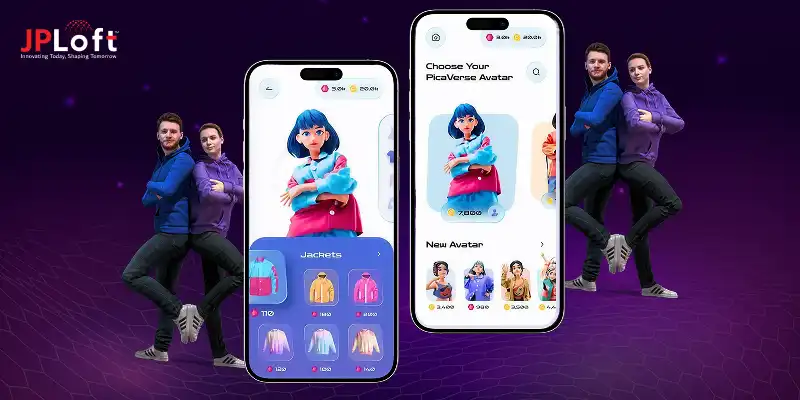Social media is evolving and many entrepreneurs are wondering how to design a social media app that users can’t stop scrolling through?
In today’s digital world, social media isn’t just about connection, it’s about creating seamless, addictive, and intuitive experiences. Whether you're a startup founder or a curious creator, understanding the steps of designing a social media app is the first move toward building something impactful.
This blog will walk you through a practical social media app design guide that covers everything from user flow to UI essentials. So, if you're ready to turn your app idea into the next big move, you’re in the right place.
Social Media App Market and Related Statistics
The social media landscape continues to evolve at lightning speed, making it an incredibly lucrative space for entrepreneurs, startups, and enterprises.
Understanding the social media app trends, statistics and user behavior is crucial before you design or invest in a platform. Here are some up-to-date statistics that paint a clear picture:
-
According to Grand View Research, in 2022, the global social networking app market was valued at $ 49.09 billion, and it’s projected to grow at a CAGR of 26.2% between 2023 and 2030, reflecting a strong and sustained demand for social media platforms worldwide.
-
A study by Statista shows that the total revenue from social media apps is anticipated to grow at an annual rate (CAGR 2022–2029) of 7.56%, reaching an estimated market volume of $ 206.76 billion by 2029.
-
Emerging trends of social media apps include AI-driven personalization, AR integration, and privacy-first design frameworks. These innovations are shaping the next generation of platforms, making user experiences more immersive, secure, and tailored.
-
Market Research Future reported that The social networking app market is expected to expand from $117.18 billion in 2025 to $837.32 billion by 2034, registering a compound annual growth rate (CAGR) of 24.42% throughout the forecast period from 2025 to 2034.
-
Social media platforms with clean UI/UX and smart algorithmic feeds like Instagram, YouTube, and LinkedIn see the highest retention and growth rates.
Whether you're building a niche community or the next global sensation, these numbers highlight the immense potential of well-crafted social platforms. Staying aligned with user behavior and market demands is key to long-term success.
Overview of Social Media App Design
Designing a successful social media app requires more than just aesthetics, it’s about building an engaging, intuitive, and seamless experience for users.
If you're exploring how to design a social media app, understanding the foundation of its structure is essential. Here’s a quick overview to get you started:
-
User-First Approach: A strong social media app design always begins with understanding your audience, what they need, love, and expect from a social platform.
-
Clean & Intuitive UI: One of the key tips for designing social media app interfaces is to keep it clean, clutter-free, and easy to navigate, even for first-time users.
-
Personalized Feeds & Smart Algorithms: The core of the design of social media apps lies in delivering relevant content through AI-powered recommendations and customizable feeds.
-
Smooth Onboarding & Login Flow: Simplify sign-up with email, OTP, or social login options, a crucial part of the designing of social media apps that boosts user retention.
-
Interactive Features: Including likes, comments, shares, and stories, these are core social media app design ideas that keep users engaged and coming back.
-
Focus on Visual Appeal: Use vibrant colors, modern icons, and micro-animations to enhance UX while maintaining brand identity across the app. The best mobile app development company ensures these elements are perfectly aligned to deliver a visually consistent and engaging user experience.
-
Real-Time Notifications & Updates: Ensure users stay connected through timely alerts and real-time activity, an essential part of any smart social media app design.
A thoughtful social media app design doesn’t just look good, it feels right to the user. By blending functionality with creativity and following smart tips for designing social media apps, you can craft an experience users won’t want to leave.
Social Media App Design Components
If you're thinking about how to design a social media app, it all starts with understanding the core building blocks. These components shape the overall experience and make your app feel smooth, modern, and user-friendly:
-
User Onboarding Screens: The first few screens set the tone. A good UI/UX social media app design includes a guided onboarding flow that helps users understand the features, sign up quickly, and feel instantly connected.
-
Profile & Account Management: Every user wants their profile to reflect who they are. The social media app interface design should offer smooth options to edit bios, change pictures, update preferences, and manage account settings with ease.
-
Home Feed / Timeline: This is the main screen users will interact with. A well-planned social media app UI design organizes content in a way that’s visually appealing, scrollable, and personalized to each user’s interests.
-
Posts, Stories & Media Upload: Whether it's sharing a quick update or posting a video, the ability to create content should feel natural. When you design a social media app, make the upload process fast, flexible, and mobile-friendly.
-
Chat & Real-Time Messaging: Social apps are all about connections. Include a sleek, real-time messaging feature that supports emojis, media sharing, and notifications, an essential part of a strong UI/UX social media app design.
-
Push Notifications: Remind users about likes, messages, tags, and trending posts. Timely notifications built into your social media app interface design can significantly boost user engagement.
To design a social media app that users love, you need more than just features, you need a flow that feels natural. Focus on these components, and you’ll be on the right track to crafting a user-centric and impactful app.
Why Do You Need an Attractive Social Media UI/UX?
A well-designed user interface (UI) and user experience (UX) can make or break your app. When you design a social media app, these elements are not just about looks, they directly impact how users feel, engage, and stay.
Here's why investing in quality social media app UI design and social media app interface design matters:
|
Reason |
Explanation |
|
First Impressions Matter |
A visually appealing social media app design creates trust and encourages users to explore your app right from the start. |
|
Boosts User Engagement |
Smooth UI/UX social media app design helps users navigate easily, spend more time, and interact more often with content. |
|
Reduces Bounce Rate |
Users are less likely to leave when the app is easy to use, which is a key goal in the designing of social media apps. |
|
Increases User Retention |
Great design brings users back. A clean, responsive social media app UI design keeps your audience engaged long-term. |
|
Enhances Brand Identity |
A unique and attractive design helps your app stand out and builds a recognizable look and feel. |
|
Supports Better Functionality |
A smartly built social media app interface design not only looks good but also makes the app intuitive and glitch-free. |
|
Encourages Content Sharing |
The easier it is to post and share, the more users will do it. That’s why tips for designing social media app often emphasize usability. |
|
Builds Emotional Connection |
Users connect more with apps that feel personalized and visually pleasing, one of the goals when you design a social media app. |
An attractive design isn't just decoration, it's strategy. If you're serious about learning how to design a social media app that users will love and stick with, focus on building a UI/UX that delivers both form and function.
How to Design a Social Media App?
Creating a social media platform is more than just combining features, it’s about building a complete, user-focused experience.
If you're wondering how to design a social media app that stands out, attracts users, and keeps them engaged, this section will clear your thoughts with every essential step of the journey.
Let’s explore this complete guide to social media app design:
1. Define the App’s Purpose and Target Audience
Begin with the “why” and “who.” Understanding the app’s core purpose and your target users’ needs lays the foundation for every design decision.
Whether you aim to create a social media app for professionals, creators, or niche communities, knowing your audience will help you tailor features, branding, and interface elements accordingly.
2. Map Out the User Experience (UX) Flow
Designing a smooth and logical user journey is key. Outline how users will interact with the app, from sign-up to daily usage. This helps ensure that every step feels intuitive.
A well-thought-out user experience is the foundation of great social media app design and improves usability, engagement, and retention. To achieve this, you might choose to hire dedicated developers who specialize in UX design, ensuring a seamless integration between design and functionality.
3. Design a Visually Compelling UI
Now it’s time to bring your app to life. In this phase, you focus on the actual visual design colors, typography, icons, buttons, and spacing.
A strong social media app UI design aligns with your brand identity while offering a clear, clutter-free layout. Keep consistency in design elements and focus on accessibility to enhance the overall user experience.
3. Wireframing the App Layout
Before diving into visuals, app wireframing gives you a skeletal layout of each screen. This step allows you to sketch out the structure of your app without any distractions of colors or images.
Wireframes define how content and navigation will flow, making it easier to identify layout issues early. It's a must in the early stages of designing a social media app.
4. Prototyping the User Journey
Once wireframes are in place, turn them into interactive app prototypes. It simulates real user interaction and help stakeholders or test users experience how the app will function.
This step bridges the gap between concept and reality, making it easier to refine the social media app interface design before development begins.
5. Validate Through User Testing
After prototyping and UI design, test your app design with real users. Watch how they interact with different screens and gather feedback to uncover pain points or confusion.
App testing is a crucial step in building a UI/UX social media app design that feels natural and friction-free.
6. Prioritize Core Features That Add Value
When you design a social media app, always prioritize the features users care about most. Think user profiles, content feeds, post creation, media sharing, likes, comments, real-time chat, and push notifications.
These features should be intuitively placed and easy to interact with, reducing cognitive load and increasing session time.
7. Design a Social Media App for Android & iOS
To reach a wider audience, it's crucial to design a social media app for Android & iOS with platform-specific guidelines in mind. While Android follows Material Design and iOS uses Apple’s design principles, maintaining a consistent brand identity and core features across both platforms is key.
Developers often face social media app development challenges such as adapting to different screen sizes, optimizing performance, and aligning with both Android and iOS design standards.
Tackling these hurdles smartly ensures your app delivers a unified and polished experience across platforms.
Learning how to design a social media app isn’t just about knowing the tools, it’s about mastering the flow, functionality, and emotional connection. If you follow this complete guide to social media app design, you won’t just create an app, you’ll create one that truly resonates with your audience.
Cost of Social Media App Design
The cost of designing a social media app typically ranges between $20,000 and $50,000+, depending on various factors like complexity, features, and platform support.
Understanding these costs is important when planning to design a social media app that meets your goals without surprises. Also, the social media app development cost can increase with advanced features or animations, but a well-designed app provides lasting value.
Below is a detailed breakdown of the typical expenses involved in the UI/UX design of your social media app and the process to design a social media app:
|
Design Phase |
Description |
Estimated Cost (USD) |
|
Market Research & User Analysis |
Understanding user needs, audience behavior, and industry trends |
$2,000 – $4,000 |
|
Wireframing |
Creating basic app layouts and screen structures |
$1,500 – $3,000 |
|
UI/UX Design |
Designing the visual elements, user interface, and experience |
$5,000 – $10,000 |
|
Prototyping |
Interactive version of the app for testing user flow and interface |
$3,000 – $6,000 |
|
Multi-Platform Design (Android & iOS) |
Designing for both platforms with native patterns and optimized UI |
$4,000 – $8,000 |
|
Design Revisions & Testing |
Iterating based on feedback and fixing usability issues |
$2,000 – $5,000 |
Choosing the right design team to design your social media app can make a huge difference in quality and user retention. A well-designed app provides lasting value and an amazing user experience.
Top Social Media Apps & Their Design
When learning how to design a social media app, it's essential to know about the best social media apps that have already set industry standards.
These apps not only showcase excellent UI/UX social media app design but also provide great insights into user engagement and revenue generation.
Here’s a breakdown of the top 5 platforms and why their design stands out:
1. Instagram
Instagram is known for its clean and immersive visual design. Its social media app interface design puts content at the center, focusing on photos, stories, and reels.
The app’s minimalistic UI ensures users aren’t distracted, while features like shopping, ads, and brand collaborations demonstrate exactly how social media apps make money.
If you're looking to design your social media app around visual content, Instagram is a perfect reference.
2. Facebook
Facebook’s interface is robust yet surprisingly intuitive. Despite offering a wide range of features, feeds, groups, events, and a marketplace. The UI/UX social media app design is structured to keep things organized.
It's ideal if you want to design a social media app for Android & iOS that serves multiple purposes.
3. YouTube
YouTube transformed the digital content landscape with its video-first approach and user-generated ecosystem. Its social media app design is optimized for discovery, content creation, and long watch times.
The layout ensures smooth navigation between videos, comments, playlists, and channels, enhancing both the viewing and creator experience.
If you're planning to develop an app like YouTube, try to design your social media app with long-form content or community interaction in mind, YouTube's structure is worth studying.
4. LinkedIn
Designed specifically for professionals, LinkedIn’s interface is sleek, minimal, and goal-driven. Its focus is on networking, job searching, and thought leadership. The app doesn’t overwhelm users with visuals but instead uses whitespace and clear navigation.
If your goal is to design a social media app for a niche or professional audience, LinkedIn offers a masterclass in targeted social media app design.
5. Snapchat
Snapchat’s design is playful, intuitive, and unlike any other platform. With a camera-first approach and disappearing messages, it encourages real-time interaction. The app also leads in AR features and unique monetization strategies like premium filters and Snap Originals.
For developers aiming to create something innovative, Snapchat shows that bold social media app UI design choices can set trends. However, exploring Snapchat alternatives can provide additional insights and inspiration that might influence your development strategy.
These top platforms provide not only inspiration but also a blueprint for success. Whether you're planning to design a social media app or a niche audience, understanding what works for the giants can help you build something just as impactful.
Partner With JPLoft to Create an Engaging Social Media App Design
Looking to turn your idea into a visually stunning and user-centric app? JPLoft is your trusted partner in crafting modern, scalable, and intuitive social platforms.
As a leading social media app development company, we specialize in UI/UX strategies that drive engagement and user retention across Android and iOS. From idea validation and wireframing to high-fidelity UI design and interactive prototypes, we ensure every pixel reflects your brand and user needs.
Whether you're building for a niche audience or aiming for a global user base, our experienced designers and developers work hand-in-hand to bring your vision to life.
Let’s collaborate to build a design that doesn’t just look great, but performs brilliantly.
Final Wrap-Up
Designing a successful social media app isn’t just about picking the right features, it’s about creating a seamless, engaging, and intuitive experience that keeps users coming back.
From understanding your audience and crafting user flows to wireframing, prototyping, and UI/UX refinement, every step plays a vital role in turning your idea into a powerful product. If you’re ready to design a social media app that stands out in a crowded digital space, don’t settle for average.
Invest in smart design, real user feedback, and platform-specific strategies to ensure long-term success. Whether it's for Android, iOS, or both, remember, great design isn’t a one-time task; it’s a user-driven journey.
If you need expert help, JPLoft is here to turn your vision into a fully functional, high-impact social media platform.
FAQs
The cost to design a social media app typically ranges from $20,000 to $50,000+, depending on complexity, features, and platform support.
Core components include user-friendly navigation, attractive UI, interactive news feeds, user profiles, messaging systems, and mobile responsiveness for both Android & iOS.
Great UI/UX improves user engagement, boosts retention, and delivers a smooth user journey, making it a critical factor in your app’s long-term success.
Use cross-platform design strategies with platform-specific UI patterns to ensure consistency and a native feel across both platforms.
Wireframing outlines the basic structure of your app, while prototyping adds interactivity to simulate real user flows and test usability before development.













Share this blog